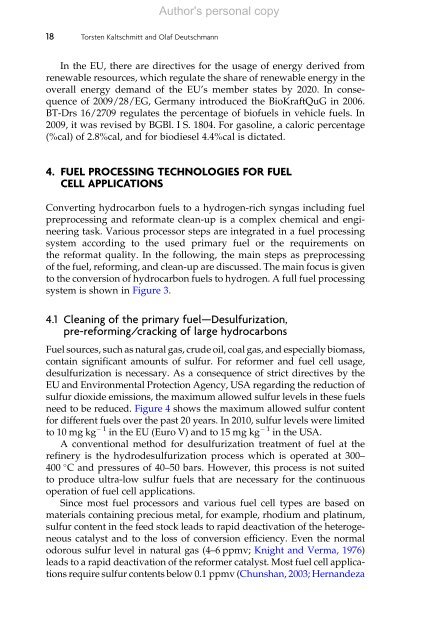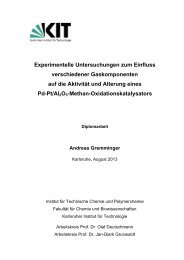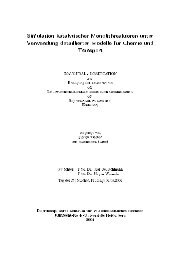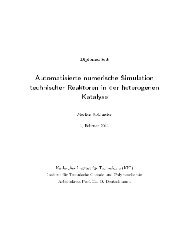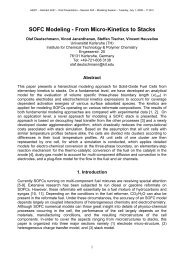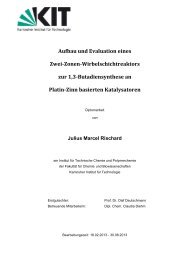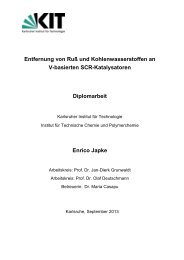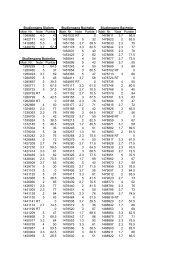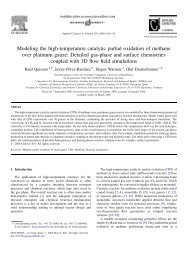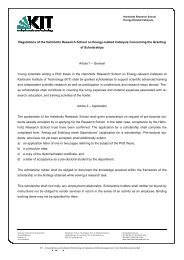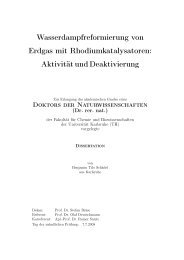Fuel Processing for Fuel Cells - Institut für Technische Chemie und ...
Fuel Processing for Fuel Cells - Institut für Technische Chemie und ...
Fuel Processing for Fuel Cells - Institut für Technische Chemie und ...
You also want an ePaper? Increase the reach of your titles
YUMPU automatically turns print PDFs into web optimized ePapers that Google loves.
Author's personal copy<br />
18 Torsten Kaltschmitt and Olaf Deutschmann<br />
In the EU, there are directives <strong>for</strong> the usage of energy derived from<br />
renewable resources, which regulate the share of renewable energy in the<br />
overall energy demand of the EU’s member states by 2020. In consequence<br />
of 2009/28/EG, Germany introduced the BioKraftQuG in 2006.<br />
BT-Drs 16/2709 regulates the percentage of biofuels in vehicle fuels. In<br />
2009, it was revised by BGBl. I S. 1804. For gasoline, a caloric percentage<br />
(%cal) of 2.8%cal, and <strong>for</strong> biodiesel 4.4%cal is dictated.<br />
4. FUEL PROCESSING TECHNOLOGIES FOR FUEL<br />
CELL APPLICATIONS<br />
Converting hydrocarbon fuels to a hydrogen-rich syngas including fuel<br />
preprocessing and re<strong>for</strong>mate clean-up is a complex chemical and engineering<br />
task. Various processor steps are integrated in a fuel processing<br />
system according to the used primary fuel or the requirements on<br />
the re<strong>for</strong>mat quality. In the following, the main steps as preprocessing<br />
of the fuel, re<strong>for</strong>ming, and clean-up are discussed. The main focus is given<br />
to the conversion of hydrocarbon fuels to hydrogen. A full fuel processing<br />
system is shown in Figure 3.<br />
4.1 Cleaning of the primary fuel—Desulfurization,<br />
pre-re<strong>for</strong>ming/cracking of large hydrocarbons<br />
<strong>Fuel</strong> sources, such as natural gas, crude oil, coal gas, and especially biomass,<br />
contain significant amounts of sulfur. For re<strong>for</strong>mer and fuel cell usage,<br />
desulfurization is necessary. As a consequence of strict directives by the<br />
EU and Environmental Protection Agency, USA regarding the reduction of<br />
sulfur dioxide emissions, the maximum allowed sulfur levels in these fuels<br />
need to be reduced. Figure 4 shows the maximum allowed sulfur content<br />
<strong>for</strong> different fuels over the past 20 years. In 2010, sulfur levels were limited<br />
to 10 mg kg 1 in the EU (Euro V) and to 15 mg kg 1 in the USA.<br />
A conventional method <strong>for</strong> desulfurization treatment of fuel at the<br />
refinery is the hydrodesulfurization process which is operated at 300–<br />
400 C and pressures of 40–50 bars. However, this process is not suited<br />
to produce ultra-low sulfur fuels that are necessary <strong>for</strong> the continuous<br />
operation of fuel cell applications.<br />
Since most fuel processors and various fuel cell types are based on<br />
materials containing precious metal, <strong>for</strong> example, rhodium and platinum,<br />
sulfur content in the feed stock leads to rapid deactivation of the heterogeneous<br />
catalyst and to the loss of conversion efficiency. Even the normal<br />
odorous sulfur level in natural gas (4–6 ppmv; Knight and Verma, 1976)<br />
leads to a rapid deactivation of the re<strong>for</strong>mer catalyst. Most fuel cell applications<br />
require sulfur contents below 0.1 ppmv (Chunshan, 2003; Hernandeza


